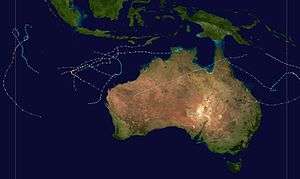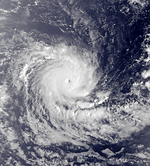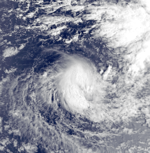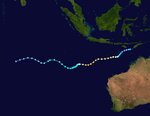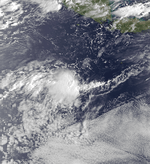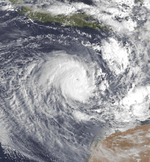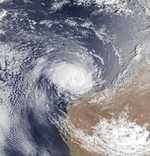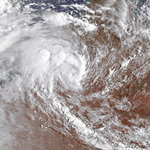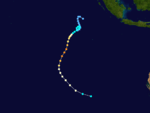1980–81 Australian region cyclone season
1980–81 Australian region cyclone season
| |
| Season summary map |
| First system formed |
3 November 1980 |
| Last system dissipated |
30 May 1981 |
| Strongest storm1 |
Mabel – 930 hPa (mbar), 205 km/h (125 mph) (10-minute sustained) |
| Tropical lows |
14 |
| Tropical cyclones |
14 |
| Severe tropical cyclones |
11 |
| Total fatalities |
Unknown |
| Total damage |
Unknown |
| 1Strongest storm is determined by lowest pressure |
Australian region tropical cyclone seasons
1978–79, 1979–80, 1980–81, 1981–82, 1982–83 |
| Related articles |
|
|
The 1980–81 Australian region cyclone season was an average season. It officially started on 1 November 1980, and officially ended on 30 April 1981.
Storms
Severe Tropical Cyclone Alice-Adelaide
| Category 4 severe tropical cyclone (Australian scale) |
| Category 3 tropical cyclone (SSHWS) |
|
|
| Duration |
November 3 – November 10 (Crossed 80°E) |
| Peak intensity |
185 km/h (115 mph) (10-min) 940 hPa (mbar) |
Formed on November 3, just south of Selat Mentawai then moved southwestward before reaching a peak intensity of 110 knots (125 mph, 205 km/h) and a minimum pressure of 940.0 hectopascals (27.76 inHg) on November 8. On November 12 the storm began to move northwestward and two days later dissipated over the open Indian Ocean.
Severe Tropical Cyclone Bert-Christelle
| Category 3 severe tropical cyclone (Australian scale) |
| Category 1 tropical cyclone (SSHWS) |
|
|
| Duration |
November 24 – December 3 (Crossed 80°E) |
| Peak intensity |
150 km/h (90 mph) (10-min) 965 hPa (mbar) |
Severe Tropical Cyclone Carol
| Category 4 severe tropical cyclone (Australian scale) |
| Category 3 tropical cyclone (SSHWS) |
|
|
| Duration |
December 12 – December 22 |
| Peak intensity |
185 km/h (115 mph) (10-min) 940 hPa (mbar) |
Tropical Cyclone Dan
| Category 2 tropical cyclone (Australian scale) |
| Tropical storm (SSHWS) |
|
|
| Duration |
December 14 – December 18 |
| Peak intensity |
100 km/h (65 mph) (10-min) 985 hPa (mbar) |
Tropical Cyclone Edna
| Category 1 tropical cyclone (Australian scale) |
| Tropical storm (SSHWS) |
|
|
| Duration |
December 20 – December 27 |
| Peak intensity |
65 km/h (40 mph) (10-min) 994 hPa (mbar) |
Severe Tropical Cyclone Felix
| Category 4 severe tropical cyclone (Australian scale) |
| Category 3 tropical cyclone (SSHWS) |
|
|
| Duration |
December 22 – December 31 |
| Peak intensity |
185 km/h (115 mph) (10-min) 940 hPa (mbar) |
Severe Tropical Cyclone Mabel
| Category 5 severe tropical cyclone (Australian scale) |
| Category 3 tropical cyclone (SSHWS) |
|
|
| Duration |
January 12 – January 21 |
| Peak intensity |
205 km/h (125 mph) (10-min) 930 hPa (mbar) |
Severe Tropical Cyclone Eddie
| Category 3 severe tropical cyclone (Australian scale) |
| Tropical storm (SSHWS) |
|
|
| Duration |
February 8 – February 13 |
| Peak intensity |
120 km/h (75 mph) (10-min) 981 hPa (mbar) |
Tropical Cyclone Cliff
| Category 2 tropical cyclone (Australian scale) |
| Category 1 tropical cyclone (SSHWS) |
|
|
| Duration |
February 13 (Crossed 160°E) – February 15 |
| Peak intensity |
110 km/h (70 mph) (10-min) 985 hPa (mbar) |
After ravaging the South Pacific islands, Cyclone Cliff struck Queensland on February 14, 1981. The effects of the cyclone was felt from Noosa to Burleigh Heads on the Gold Coast. One person died in the storm.[1]
Severe Tropical Cyclone Neil
| Category 4 severe tropical cyclone (Australian scale) |
| Category 3 tropical cyclone (SSHWS) |
|
|
| Duration |
February 24 – March 7 |
| Peak intensity |
185 km/h (115 mph) (10-min) 940 hPa (mbar) |
Severe Tropical Cyclone Freda
| Category 3 severe tropical cyclone (Australian scale) |
| Tropical storm (SSHWS) |
|
|
| Duration |
February 24 – March 3 (Crossed 160°E) |
| Peak intensity |
120 km/h (75 mph) (10-min) 974 hPa (mbar) |
Severe Tropical Cyclone Max
| Category 3 severe tropical cyclone (Australian scale) |
| Category 3 tropical cyclone (SSHWS) |
|
|
| Duration |
March 9 – March 19 |
| Peak intensity |
150 km/h (90 mph) (10-min) 960 hPa (mbar) |
Cyclone Max developed from a low pressure system into a Category 1 cyclone in Van Diemen Gulf, off the Northern Territory Coast, on March 11, 1981. Moving west-southwest, it crossed over Darwin, Australia later that day, causing tree damage and flooding but minimal structural damage. It subsequently moved west into the Timor Sea and the Indian Ocean, and although intensifying to Category 3 and reaching a lowest pressure of 960.0 hectopascals (28.35 inHg), did not approach land again.[2] Max was notable for being the first cyclone to pass over Darwin since the city was destroyed by Cyclone Tracy 6 years earlier. The name Max was not retired from the Northern Australia naming list.
Severe Tropical Cyclone Olga
| Category 4 severe tropical cyclone (Australian scale) |
| Category 4 tropical cyclone (SSHWS) |
|
|
| Duration |
April 5 – April 15 |
| Peak intensity |
185 km/h (115 mph) (10-min) 940 hPa (mbar) |
Severe Tropical Cyclone Paddy
| Category 3 severe tropical cyclone (Australian scale) |
| Tropical storm (SSHWS) |
|
|
| Duration |
May 24 – May 30 |
| Peak intensity |
130 km/h (80 mph) (10-min) 973 hPa (mbar) |
See also
- Atlantic hurricane seasons: 1980, 1981
- Eastern Pacific hurricane seasons: 1980, 1981
- Western Pacific typhoon seasons: 1980, 1981
- North Indian Ocean cyclone seasons: 1980, 1981
References
